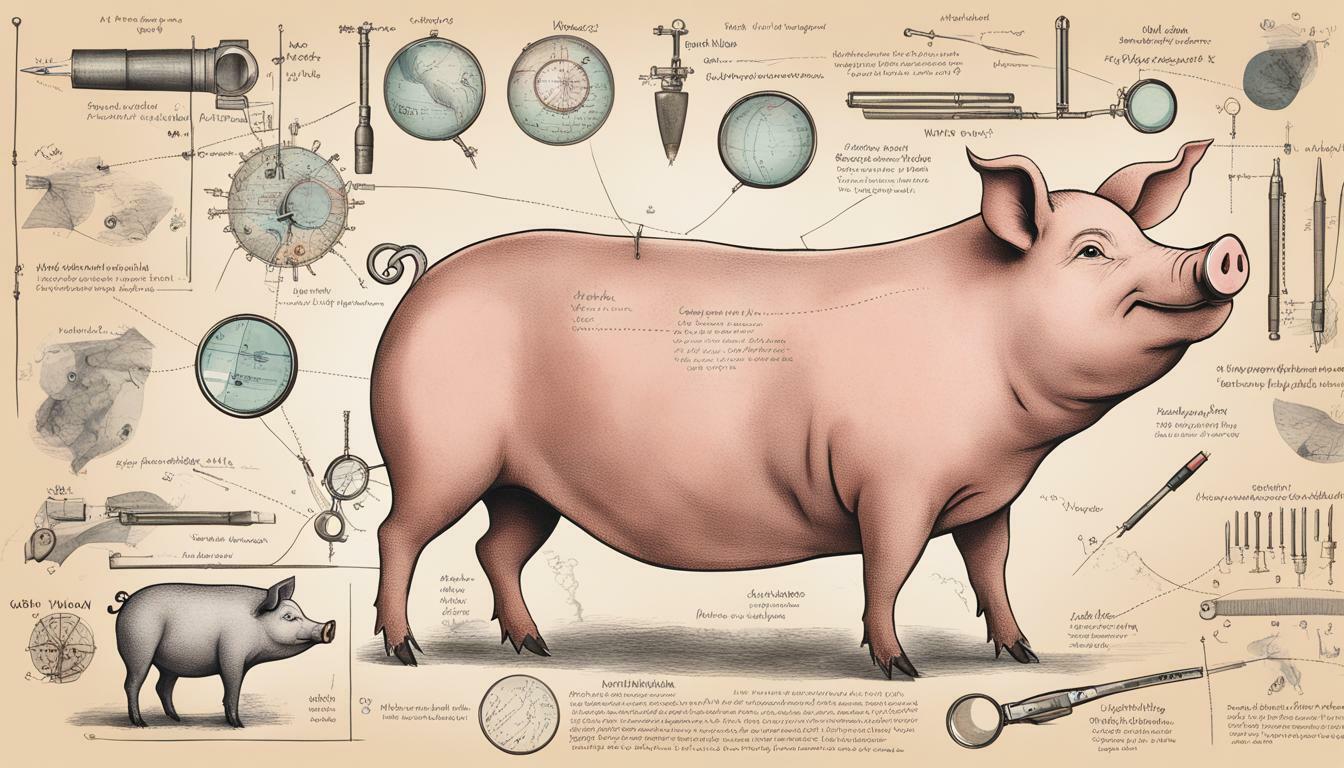Do Pigs Have Whiskers? Uncovering the Truth

Table of content:
If you’ve ever found yourself wondering whether pigs have whiskers or not, you’re not alone. The topic has been a subject of debate and confusion among animal enthusiasts and scientists alike for years. Some claim that pigs do have whiskers, while others argue that they don’t. In this article, we’ll delve into the anatomy of pigs and explore the truth about whether or not these cute farm animals have facial hair akin to cat whiskers.
The Anatomy of a Pig
Before exploring the topic of pig whiskers, it’s important to understand the overall anatomy of these animals. Pigs belong to the family Suidae, which includes wild boars and domesticated pigs. They have a stocky, compact body with short legs and a rounded head.
Pigs have a unique facial structure, which includes a snout that is used for rooting and foraging. This snout is packed with sensory nerves that allow pigs to detect odors and navigate through their environment. They also have a set of powerful jaws that enable them to crush and grind their food.
Another important feature of a pig’s face is their eyesight. They have small, beady eyes that are located on the sides of their head. This placement allows for a wide field of vision, but their eyesight is not particularly strong.
Perhaps the most relevant aspect of a pig’s anatomy when discussing their whiskers is their sensory organs. These are used for many purposes, including detecting movement, locating food, and sensing changes in their environment.
Pig Whiskers: Fact or Fiction?
There has been a longstanding debate over whether or not pigs have whiskers. Some people believe that pigs do not have whiskers, while others are convinced that they do. Let’s explore this topic and get to the truth.
Myth: Pigs Do Not Have Whiskers
- One argument against the existence of pig whiskers is that they are not visible to the naked eye.
- Additionally, pigs have relatively short hair that covers their bodies, which makes it difficult to distinguish any specific type of hair.
- It is also commonly believed that pigs rely on their sense of smell, rather than their sense of touch, making whiskers unnecessary.
Fact: Pigs Do Have Whiskers
- Pigs have been shown to have whiskers, albeit not as prominent as those found on cats or rats.
- Whiskers on pigs are sensory organs called vibrissae, which are specialized hairs that are connected to nerve endings.
- Vibrissae serve as a type of touch receptor, allowing pigs to navigate their surroundings and find food.
- Studies have shown that pigs with damaged whiskers have a harder time finding food and navigating their environment.
Overall, while pig whiskers may not be as prominent as those found on other animals, they do exist and serve an important purpose in a pig’s sensory perception and navigation abilities.
Unveiling the Truth: Do Pigs Have Whiskers?
Despite the common misconceptions, scientific evidence confirms that pigs do have whiskers. These sensory organs, also known as vibrissae, are present on their snouts and provide valuable information about their surroundings.
The whiskers on pigs are thicker and stiffer than their regular hair and have a deeper root, allowing them to detect movements and vibrations in the air. This helps them navigate their environment, locate food, and avoid predators.
Studies have also shown that pig whiskers play a critical role in their social interactions. They use their whiskers to communicate with other pigs, conveying their emotional state and intentions.
The Function of Pig Whiskers
Pig whiskers have a rich sensory network of nerve endings at the base, making them highly sensitive to touch. They can detect subtle changes in their environment, such as temperature, moisture, and texture.
When pigs move their whiskers, they create a sensory map of their surroundings. This allows them to navigate their environment with ease, identify food sources, and avoid obstacles.
Furthermore, pig whiskers serve as an early warning system for danger. Pigs are highly sensitive to vibrations and movements, and their whiskers allow them to detect approaching predators before they come into view.
The Importance of Pig Whiskers
Pig whiskers play a critical role in their survival, enabling them to navigate their environment, communicate with other pigs, and avoid danger. Their exceptional sensory abilities make them highly adaptable to various environments, and they can quickly adjust to changes in their environment.
Understanding the function and importance of pig whiskers can help us better appreciate and care for these intelligent and complex animals.
The Importance of Pig Whiskers
Pig whiskers may seem insignificant, but they have a crucial role in the sensory perception and navigation abilities of these animals. Whiskers are part of a pig’s sensory system along with their nose, ears and eyes.
Pigs use their whiskers to navigate through dark and cramped spaces, detect the size and shape of objects, and sense changes in air pressure, temperature, and texture. These sensory organs are particularly important for domestic pigs, as they often live in confined spaces that require them to maneuver carefully.
The sensory information gathered through pig whiskers contributes significantly to their overall well-being and safety. For example, these sensory organs help them detect predators, avoid obstacles, and find food and water.
Overall, pig whiskers are a vital component of their sensory system and play a crucial role in their daily lives. Understanding the significance of these sensory organs can improve our understanding of the needs and behaviors of these intelligent animals.
The Importance of Pig Whiskers
If you thought that pig whiskers were just a quirky physical feature without any real purpose, think again. These facial hairs play a crucial role in the sensory perception and navigation abilities of pigs, making them a vital part of their anatomy.
As mentioned earlier, pig whiskers are a type of hair that grows from the snout area of the animal. They are connected to nerve endings, which send signals to the pig’s brain when they come into contact with objects in their surroundings. This allows the pig to detect and navigate obstacles around them, especially in low-light conditions where their vision may be limited.
In addition, pig whiskers also provide tactile stimulation, which is essential for the overall well-being of the animal. Pigs use their whiskers to explore their environment, interact with their surroundings, and even communicate with other pigs.
It’s also worth noting that pig whiskers are different from the hair on their body. They are thicker, longer, and more sensitive, allowing them to detect even the slightest changes in their surroundings with ease. They are also arranged in a pattern that helps the pig to gauge the size and shape of objects in their environment, indicating whether it’s safe to proceed or not.
Overall, pig whiskers are an essential part of their sensory system, providing them with valuable information about their environment. Without them, pigs would struggle to navigate and interact with their surroundings, impacting their overall quality of life.
The Conclusion: The Truth About Pig Whiskers
After exploring the anatomy of pigs and the common misconceptions surrounding pig facial hair, it has been confirmed that pigs do have whiskers.
Scientific evidence and research findings have demonstrated that pig whiskers play a crucial role in their sensory perception and navigation abilities. Their whiskers help pigs detect changes in their environment, navigate through unfamiliar spaces, and locate food.
Understanding the structure and function of pig hair has provided insight into the importance of maintaining healthy whiskers for the overall well-being of pigs.
So, the next time you come across a curly-haired pig, take a closer look, and you may just spot their fine, sensory whiskers.
Welcome. I’m Adreena Shanum, the proud owner of this website, and I am incredibly passionate about animals, especially poultry. I founded adreenapets.com as a labor of love, stemming from my desire to share my knowledge and experiences with poultry enthusiasts worldwide.




